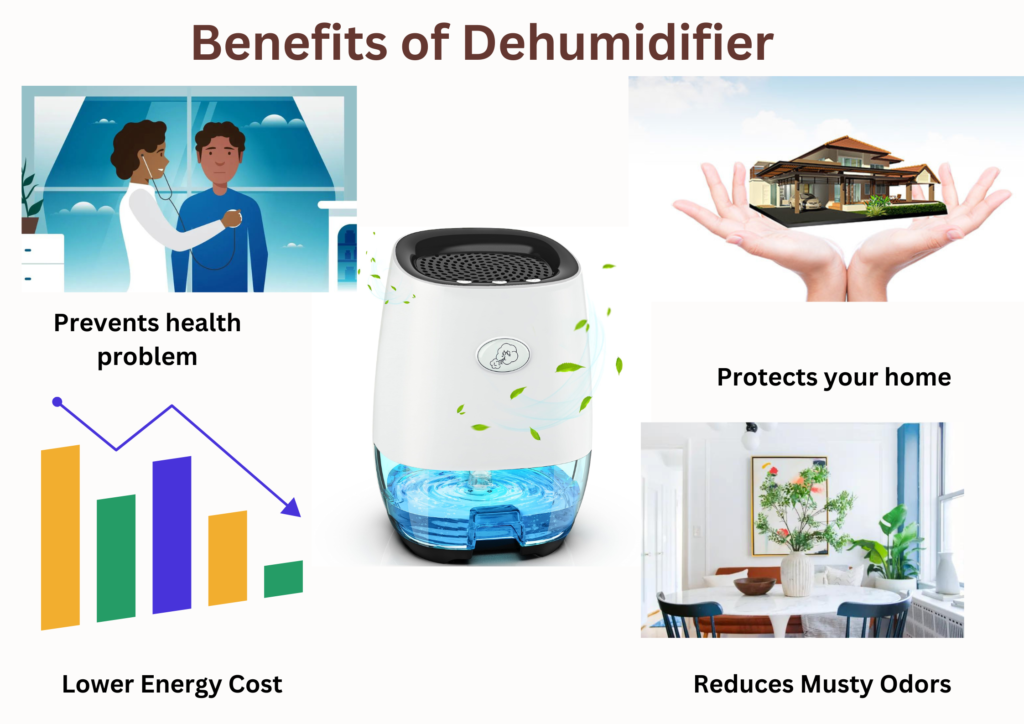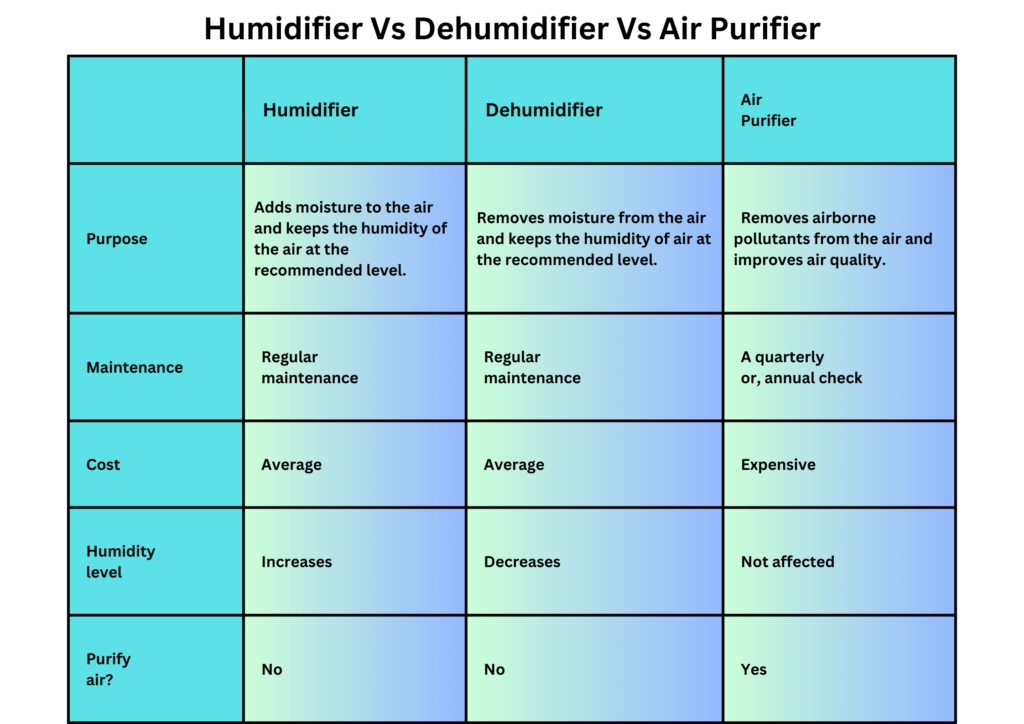Are you worried about the bad air quality in your surrounding area? People living in cities and industrial areas are suffering from various diseases due to harmful surrounding air. Breathing clean air is necessary to stay healthy. Poor air quality causes many respiratory diseases, lung cancer, severe colds, coughs, etc. Air quality can be improved by using air purifiers, humidifiers, dehumidifiers, etc.
Usually, people who live in cooler areas use humidifiers to get healthy air. Whereas people staying in coastal areas prefer dehumidifiers to keep the humidity of the indoor air at the optimal level.
So, which device should you prefer to get healthy indoor air? A clear explanation on “Humidifier Vs Dehumidifier Vs Air Purifier”, their benefits, uses are explained here. Read the full article to get detailed knowledge on humidifiers Vs dehumidifiers Vs air purifiers. It gives you a clear idea of which device you should buy to get healthy air.
Humidifier
In winter the temperature drops outside and this causes dryness in the air. Including the climate the use of air conditioning systems in summer and central heating systems in winter also makes the air dry. Dry air means less moisture in the air. Moisture or, humidity is the amount of water vapor in the air.
A humidifier adds moisture or, humidity to the air. According to the U.S. Environmental Protection Agency, the relative humidity level of the surrounding air should be kept between 30% to 50%. When the relative humidity level of the air decreases below 30% it is called low humidity. A humidifier works by increasing the moisture or humidity level of the surrounding air of a room or, the entire home.
A humidifier maintains the humidity level of the indoor air at the recommended value. An optimal humidity level creates a healthy environment free from dust mites, mold, mildew, and other organisms. The use of a humidifier prevents allergic problems, sinus problems, snoring, and dry skin.
However, the proper maintenance and cleaning of a humidifier is important to prevent possible exposure to mold and other germs.
Types of Humidifiers
Humidifiers can be classified into 2 categories i.e.,
- Warm mist humidifiers: These humidifiers release warm moisture into the air, to increase the indoor air’s humidity level. A warm mist humidifier contains a water reservoir and a heating element to boil the water. When the water boils the water vapor releases into the air as a warm mist. Steam vaporizers belong to this category.
- Cool mist humidifier: A cool mist humidifier releases cool moisture into the surrounding air to keep the humidity level at the recommended value. It contains a water reservoir, wick filter, fan, or, a vibrating element to generate cool moisture. It does not contain any heating element. Evaporative humidifiers, ultrasonic humidifiers, impeller humidifiers, and central humidifiers belong to this category.
There are mainly 5 types of humidifiers available in the market.
- Evaporative humidifiers
- Steam vaporizers
- Ultrasonic humidifiers
- Impeller humidifiers
- Central humidifiers

Benefits of Humidifier
Offers relief from sinus problems:
The dry air makes the nasal passageways dry and irritated airways generate more mucus. A humidifier maintains the humidity level of the air. Moisten air offers relief from irritation, thinning out mucus, and sinus problems like colds, coughs, stuffy nose, nasal congestion, etc.
Allergy relief:
A humidifier prevents allergic and asthma symptoms by soothing nasal and throat tissues. It also offers relief to dry and itchy throat, congested and runny nose, cough, etc.
Relieve dry skin:
A humidifier adds moisture to the air and decreases the dryness in the air. Healthy air keeps your skin moisturized and glowing. It offers relief from dry and itchy skin.
Reduce snoring:
Humidifiers help in loosening the mucus that blocks the nasal passageways. It provides relief from a congested nose. A clear nose reduces snoring problems and offers good sleep.
Dehumidifier
During the rainy season, or, foggy weather you must have experienced the heavy feeling that feels the air. It’s nothing but the humidity in the air.
If you live near a coastal region or, close to the equator you often hear the term “Humidity”. This is the high level of humidity in the air which makes you feel uncomfortable. An overly humid home can make you feel sick and damage your home. It can also make your home feel stuffy and even smell musty.
A dehumidifier is an electrical device that reduces the moisture in the air and maintains the optimal humidity level. It helps remove musty odors and prevents the growth of mold and mildew. It also helps the air conditioning system to run more efficiently and lowers the energy cost.
Working principle of Dehumidifier
A dehumidifier mainly consists of 4 components i.e.,
- Fan: A fan collects air from the surrounding area.
- Fan compressor: A fan compressor cools the dehumidifier’s coil. It compresses and expands a refrigerant gas to cool the coil.
- Reservoir: A reservoir stores water inside the device.
- Reheater: A reheater is used to reheat the air.
A dehumidifier consists of a fan that draws in the humid air into the device. The air then passes through and comes in contact with the dehumidifier’s cooled coil. The temperature of the coils is kept below the dew point of the incoming air.
When the air comes in contact with the coil, the water in the air condenses into water droplets. Thus, the coils pull moisture from the air. The collected water droplets drip into the dehumidifier’s reservoir.
The dehumidifier reheats the air and recirculated back into the room. Thus, the dehumidifiers extract moisture from the air and keep the surrounding air’s humidity at the recommended level.
Types of Dehumidifiers
There are mainly 3 types of dehumidifiers available in the market.
- Refrigerant Dehumidifier: A refrigerant dehumidifier consists of a metal plate on which the moisture from the air condenses. The moisture condenses and drips into the water reservoir and the relative humidity of the air is kept at the optimal level.
- Desiccant Dehumidifier: A desiccant humidifier consists of a desiccant which is a material that absorbs water. When the wheel consisting largely of desiccant turns slowly through the air stream, it absorbs moisture from the air.
In its rotation process, a small proportion of the wheel also passes through the stream of warm air. The condensed water generated in this process is collected in the water tank and the air with optimal moisture level is released into the air.
3. Whole House Ventilation Dehumidifier: The ventilation system is the most effective and cheaper way to remove moisture from the air in your home.

Benefits of Dehumidifier
- Prevents health problem:
When the relative humidity of a room reaches above 50%, there are high chances of the growth of mold and mildew, dust mites which cause allergic reactions. A dehumidifier reduces moisture, maintains the humidity level of air, and prevents you from being affected by allergic reactions, asthma, and respiratory diseases.
- Protects your home:
If the humidity level of the indoor air of your home is high then this can lead to various types of damage like furniture warping, paint peeling, and several other types of water damage. Installing a dehumidifier can save your home from the above issues.
- Lower Energy Cost:
If the air’s humidity level is high, the air conditioning system must work harder to not only cool the air but also to remove the moisture. A dehumidifier helps the air conditioning system run more smoothly by removing moisture from the air.
- Reduces Musty Odors:
A dehumidifier reduces moisture from the air and this also helps in reducing musty odors from the home.
Air Purifier
The tiny particles released from several things inside a home like pets, candles, cooking, decorative items, carpets, pillows, etc. can negatively impact indoor air quality. According to the U.S. Environmental Protection Agency indoor air can be five times as polluted as outdoor air. The airborne pollutants thrive inside the indoor air as it is not circulated as much as the outdoor air.
An air purifier is a portable device that consists of an internal filter and a fan to extract unwanted pollutants from the air. It improves air quality by eliminating airborne pollutants from the air that can trigger respiratory diseases, allergic infections, asthma, neurological problems, etc. Thus, an air purifier reduces the chances of several health issues and keeps you healthy.
Working principle of Air Purifier
An air purifier consists of a fan that draws air into the device and passes the air through one or more filters. The filter traps all the pollutants and recirculates the cleaner air back into the room. This filtration process repeats several times an hour which further boosts the air quality.
Types of Air Purifier
- Ultraviolet Air Purifier:
The ultraviolet air purifier uses ultraviolet rays to remove pollutants, harmful viruses, bacteria, etc. from the air. This type of air purifier is generally used in hospitals, patient rooms, laboratories, etc.
- HEPA Air Purifier:
The HEPA air purifier uses advanced filters to remove particles like dander, mold, and dust from the air. It can remove particles larger than 0.2 microns from the air.
- Ionic air purifier:
The ionic air purifier releases negative ions into the air which bond with positively charged airborne pollutants. After bonding these pollutants get so heavy that they gradually fall out of the air.
- Activated carbon air purifier:
Activated carbon air purifiers are used to remove smoke, odors, fumes, and gases from the air. These types of air purifiers are best for people who are sensitive to odors, smoke, natural gases, etc.
- Central air cleaners:
Central air cleaners are connected to the central air conditioning system or central heating system to purify the air of the entire home. These air purifiers prevent various health issues like asthma, and allergies, and keep you healthy.

Benefits of Air Purifier
- Prevents health problems:
Air purifiers can trap and inactivate common household allergens, viruses, and bacteria from the air. It prevents several health issues including respiratory diseases, allergic symptoms, asthma, common cold, etc. caused by airborne viruses and germs.
- Removes unpleasant odors:
Activated carbon air purifiers are great devices to remove odors from tobacco smoke, chemicals, natural gases, etc. These types of air purifiers contain a carbon material that traps odor-causing volatile organic compounds (VOCs) and removes unpleasant odors from the home.
- Trap dust mites
Air purifiers are able to trap small particles as well as larger pollutants like dust mites, pollen, and pet dander from the air.
Humidifier Vs Dehumidifier Vs Air Purifier

| Humidifier | Dehumidifier | Air Purifier | |
| Purpose | Adds moisture to the air and keeps the humidity of the air at the recommended level. | Removes moisture from the air and keeps the humidity of air at the recommended level. | Removes airborne pollutants from the air and improves air quality. |
| Maintenance | Regular maintenance | Regular maintenance | A quarterly or, annual check |
| Cost | Average | Average | Expensive |
| Humidity level | Increases | Decreases | Not affected |
| Purify air? | No | No | Yes |
Conclusion
Breathing clean air leads to a healthy life. The air quality should be improved to prevent respiratory diseases, heart diseases, lung cancer, severe colds, coughs, allergic symptoms, etc. The quality of the air can be enhanced by removing pollutants, dust particles, harmful viruses, and bacteria from the air.
In cities and industrial areas, many people choose air purifiers for comfortable breathing and to prevent illnesses caused by impure air. It removes airborne pollutants and makes the air healthy inside a home.
Again, maintaining the humidity of the indoor air at its optimal level is important. In winter and cold climates, people choose a humidifier to add moisture to the air and keep the humidity at the recommended level. Whereas in coastal regions or during rainy seasons the dehumidifiers are used in homes to pull out extra from the home. Breathe clean and pure air to stay healthy.
FAQS
- Is it better to have a humidifier or air purifier?
Whether to buy a humidifier or air purifier completely depends on your requirements. A humidifier is used to add moisture to the air. If you are suffering from problems regarding dry air, you must buy a humidifier to improve the air quality.
Whereas an air purifier improves air quality by eliminating airborne pollutants from the air. If you are staying in cities or industrial areas and you are suffering from diseases due to polluted air, then you should buy an air purifier to get cleaner and healthier air.
- What is the difference between a dehumidifier, a humidifier, and an air purifier?
A humidifier adds moisture to the surrounding air. A dehumidifier reduces the moisture in the air and maintains the optimal humidity level. An air purifier eliminates airborne pollutants from the air and supplies clean and healthy air to the surrounding area.


22 thoughts on “Humidifier Vs Dehumidifier Vs Air Purifier: Which One Should You Buy? 2025”